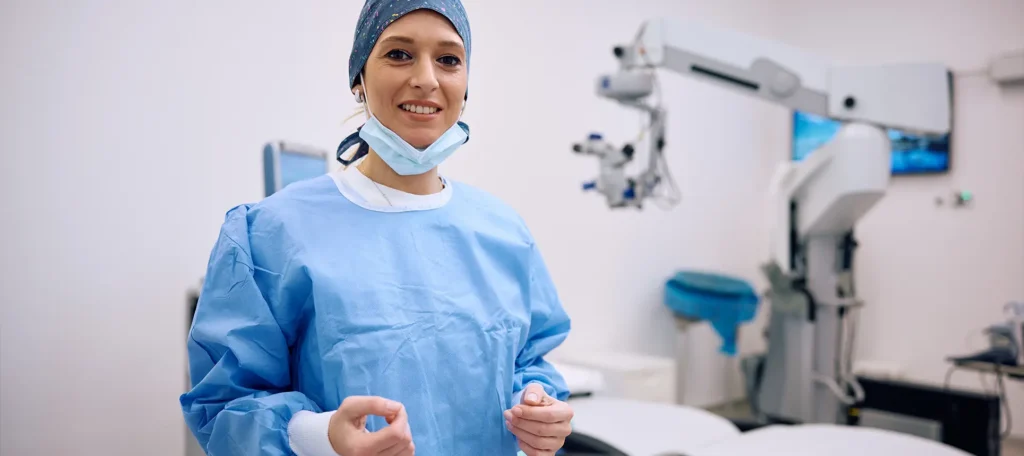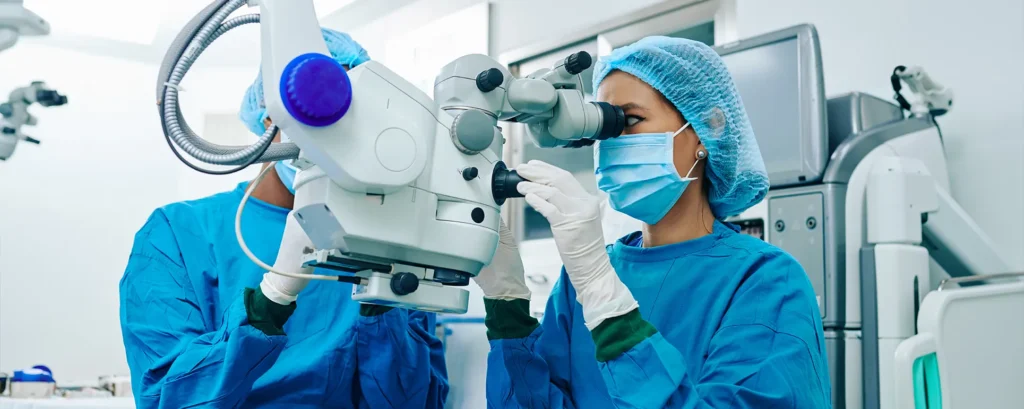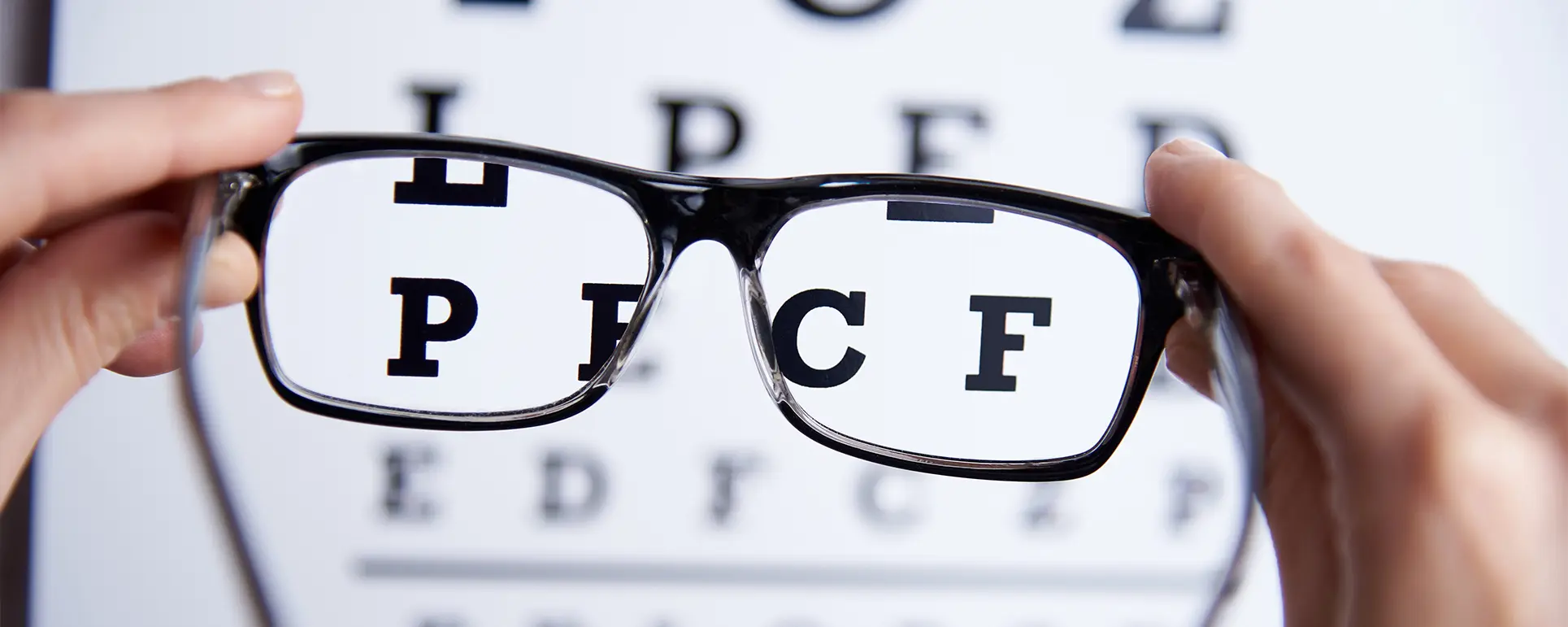If you’ve got high myopia, you’re not just dealing with a stronger glasses prescription—your eyes are structurally different, and that matters a great deal during cataract surgery. The elongated axial length that comes with high myopia presents a unique set of challenges for surgeons. From the moment you sit in the consultation chair to long after your surgery, every decision—from lens selection to how the surgery is performed—has to account for the extra complexity.
So let’s break it down. What exactly is different in the eyes of high myopes? What needs extra care during surgery? And how do we plan for the best possible visual outcomes post-op? Whether you’re a patient or a clinician looking for deeper insight, this guide covers it all.
Understanding High Myopia and Axial Elongation
It’s More Than Just “Nearsightedness”
When we say “high myopia,” we’re not just talking about someone who needs thick lenses. In ophthalmology, high myopia typically refers to a refractive error greater than -6.00 dioptres or an axial length exceeding 26.5 mm. In many cases, patients may have axial lengths well above 30 mm. This isn’t just a number on a chart—it directly affects the anatomy of the eye.
Structural Changes in the Eye
High myopic eyes are often longer than normal, meaning the distance from the front to the back of the eye is significantly increased. This can lead to thinning of the retina, posterior staphyloma (an outpouching at the back of the eye), and even abnormal positioning of intraocular structures. The sclera and choroid may be thinner, and the vitreous is more likely to have liquefied, increasing the risk of retinal detachment. All these anatomical factors complicate surgery and raise the stakes.
Biometry and IOL Power Prediction Gets Tricky
When the axial length is unusually long, standard intraocular lens (IOL) power calculation formulas start to fall short. There’s a higher likelihood of what’s known as a “hyperopic surprise” post-op—the patient ends up more farsighted than intended. This is why newer, more advanced formulae and intraoperative aberrometry are often required in high myopes to improve refractive outcomes.
Preoperative Planning: Getting It Right from the Start
Detailed Biometric Assessment
A routine scan just doesn’t cut it in high myopes. Optical biometry must be performed with care, and in some cases, ultrasound biometry might be needed if the optical media is compromised. Tools like the Barrett Universal II, Olsen, or Haigis formula tend to be more accurate in these eyes, especially when paired with swept-source OCT biometers.
Posterior Staphyloma Considerations
A posterior staphyloma can distort axial length readings if the measurement beam doesn’t account for its contour. In such cases, wide-field OCT or B-scan ultrasonography helps confirm measurements. This becomes crucial when the visual axis doesn’t line up with the deepest point of the staphyloma—something traditional A-scan biometry can easily miss.
Setting Realistic Expectations
Here’s the truth: not every high myope will walk away with perfect 6/6 vision after cataract surgery. Macular changes, staphyloma-related distortion, or previous retinal issues can limit outcomes. A candid conversation about realistic goals, including the potential need for glasses or contact lenses post-op, is essential.
Intraoperative Challenges: The Surgery Itself Isn’t Routine

Deep Anterior Chambers and Floppy Zonules
In high myopic eyes, the anterior chamber is often deep, and the zonules—those tiny fibres holding the lens in place—can be weaker or more elastic. This means the natural lens may not be as stable during surgery. Phacoemulsification requires a gentle approach and strategic use of viscoelastic to maintain chamber stability.
Capsulorhexis Difficulties
Creating a continuous curvilinear capsulorhexis (CCC) can be more challenging in these eyes due to increased capsule elasticity and poor red reflex from posterior changes. It’s also critical to size the CCC precisely to allow for stable IOL positioning post-op, especially when premium lenses are considered.
Risk of Posterior Capsule Rupture
The posterior capsule in high myopes can be thin and more fragile. Add in a longer axial length and potential for vitreous liquefaction, and the risk of rupture increases. The key is controlled fluidics and meticulous handling during the phaco process. Some surgeons even adjust the bottle height or use low-flow settings to reduce turbulence.
IOL Selection in High Myopes: A Delicate Balance
Choosing the Right IOL Type
For patients with high myopia, monofocal intraocular lenses (IOLs) remain the most dependable option. These lenses offer a single focal point, typically optimised for distance vision, which makes them more predictable in eyes with elongated axial lengths. When there are concerns about macular health, such as subtle degeneration or the presence of a posterior staphyloma, monofocal lenses avoid the potential for visual disturbances that can occur with more complex optics. Their simplicity can also help ensure better centration and stability in larger-than-average capsular bags.
Multifocal and extended depth of focus (EDOF) lenses, while attractive for their potential to reduce spectacle dependence, require perfect anatomical conditions to perform well. Even mild irregularities in the macula can degrade their performance, leading to haloes, glare, and overall dissatisfaction. In high myopes, the retinal structure is often altered, even in asymptomatic cases, making multifocal lenses a higher-risk choice. Therefore, these premium IOLs are generally reserved for eyes with confirmed macular integrity and no signs of posterior pole distortion or thinning.
Power Availability and Negative-Power Lenses
One of the more practical challenges in high myopic cataract surgery is IOL power availability. Traditional IOL ranges usually start at +6.0 dioptres and go up. However, in patients with axial lengths exceeding 30 mm, calculations can indicate the need for lenses with very low or even negative power. This means the light entering the eye needs to be diverged rather than focused more tightly—something most IOLs aren’t designed to do under standard inventory conditions.
While some IOL manufacturers produce lenses in negative powers, these are niche products and may not be readily stocked in most surgical centres. Lead times for ordering can be long, and pricing may be higher. Additionally, options in material and design are often limited at these extreme powers, reducing the surgeon’s flexibility to choose the most appropriate lens characteristics. In some cases, surgeons may need to consider piggyback lenses or other creative solutions to achieve the desired postoperative refractive target.
Refractive Targeting
Choosing a refractive target in high myopes involves balancing clinical accuracy with patient expectations. Although zero glasses might sound ideal, aiming for full emmetropia can backfire in these patients. Due to the high risk of measurement errors and formula limitations in long eyes, there’s a greater likelihood of overshooting the mark—resulting in unwanted hyperopia post-surgery. Many surgeons intentionally aim for a residual myopic outcome, such as -1.00 to -2.00 dioptres, to stay on the safer side of the refractive spectrum.
This low-level myopia often aligns more closely with how high myopic patients have functioned for most of their lives. They’re typically accustomed to seeing up close without glasses, and preserving a bit of that natural near vision can be more comfortable than forcing full distance correction. Patients who enjoy activities like reading, sewing, or using smartphones without specs often prefer this approach. It also provides a margin of safety in case of biometric inaccuracies, which are more common in extremely long eyes.
Postoperative Considerations: Healing and Visual Outcomes

Retinal Detachment Risk
Here’s the elephant in the room—retinal detachment is significantly more common after cataract surgery in high myopes. The vitreous changes, axial elongation, and previous lattice degeneration all contribute. Patients must be monitored closely, particularly in the weeks after surgery, and warned about flashes, floaters, or a sudden curtain over vision.
Posterior Capsular Opacification (PCO)
PCO tends to develop earlier in high myopes, possibly due to increased vitreous fluid dynamics and IOL-capsule interaction. Using square-edge hydrophobic acrylic lenses and ensuring good cortical cleanup during surgery can help reduce this risk. But don’t be surprised if a YAG laser capsulotomy is needed within a year or two post-op.
IOL Decentration and Stability
Because of the enlarged capsular bag and looser zonules, IOLs are at slightly higher risk of decentration or tilt. This is particularly problematic if you’ve chosen a toric or multifocal lens. For this reason, many surgeons prefer single-piece monofocal acrylic lenses, which tend to centre more reliably in these eyes.
Enhancing Outcomes with Technology
Intraoperative Aberrometry
Intraoperative aberrometry has added a new level of precision to cataract surgery, particularly in complex eyes such as those with high myopia. Systems like the ORA (Optiwave Refractive Analysis) allow the surgeon to measure the refractive power of the eye during surgery itself, once the cataract has been removed. This means lens power can be fine-tuned on the spot, taking into account real-time changes in the eye’s optics that might not have been apparent preoperatively.
High myopic eyes are known for unpredictable outcomes when it comes to IOL power prediction. The longer axial length often throws off standard formulae, leading to postoperative refractive surprises, especially hyperopia. Intraoperative aberrometry acts as a second check—adding reassurance that the chosen IOL power aligns with the patient’s desired refractive outcome. This is especially valuable when the biometric results are borderline or when unusual anatomical features complicate decision-making.
However, it’s important to note that intraoperative aberrometry is not infallible. Factors such as corneal hydration, intraocular pressure fluctuations, or even eye movement can affect the readings. While it can reduce uncertainty, it should be viewed as one tool among many rather than a guarantee. Surgeons often combine its readings with preoperative data and personal experience to make the final decision on lens power.
Intraoperative OCT
Intraoperative optical coherence tomography (OCT) offers another dimension of imaging during cataract surgery, particularly useful in patients with long axial lengths or distorted posterior segments. Unlike traditional visualisation, intraoperative OCT provides cross-sectional imaging of the anterior and posterior segments in real time. This allows the surgeon to see structural details that would otherwise be invisible through the microscope alone.
For high myopic patients, intraoperative OCT can be particularly helpful in confirming the integrity of the capsular bag, evaluating the depth of the anterior chamber, and guiding IOL positioning. This is especially relevant when posterior staphyloma, thin capsules, or vitreoretinal interface issues complicate the anatomy. Being able to see beneath the surface in real time adds a layer of safety in difficult cases.
Although it is a valuable tool, intraoperative OCT is not required for all cataract surgeries. Many experienced surgeons perform highly successful procedures without it. That said, its use is growing in more complex or high-risk eyes, where an extra layer of visual guidance can reduce intraoperative uncertainty and support better decision-making. It is particularly useful when combined with careful preoperative imaging and a well-thought-out surgical plan.
Femtosecond Laser Assistance

Femtosecond laser-assisted cataract surgery (FLACS) has become an option in many modern surgical centres, offering a computer-controlled method for performing some of the key steps in cataract surgery. These include the capsulotomy, corneal incisions, and lens fragmentation. For high myopes, where the anterior chamber may be deeper and the lens zonules less stable, some surgeons find the consistent precision of laser-created incisions helpful.
In particular, creating a well-centred and optimally sized capsulotomy can be more challenging in high myopic eyes due to anatomical differences. The femtosecond laser can assist by automating this step, which may help with IOL centration and stability later on. Similarly, pre-fragmenting the lens can reduce the amount of phacoemulsification energy needed, which may be beneficial in certain cases where the posterior capsule is particularly fragile.
However, it’s essential to clarify that femtosecond laser assistance is not inherently superior to traditional manual techniques. Well-executed manual surgery remains highly effective and safe, even in high myopic eyes. The decision to use FLACS often comes down to surgeon preference, equipment availability, and the specific characteristics of the eye being treated. It is one option among many—not a universal necessity.
Psychological Considerations in High Myopes
Anxiety Around Vision Loss
Many high myopes have been dependent on glasses or contacts their entire lives. For them, the thought of cataract surgery can provoke a lot of anxiety—not just about the procedure, but about potential outcomes and the loss of the “vision” they’ve adjusted to over decades. It’s not just about correcting a lens opacity; it’s about redefining how they interact with the world visually.
Post-Surgery Adaptation
The brain of a high myope may take longer to adjust to the new refractive status post-op, especially if there’s a significant shift from extreme myopia to plano. Some report distorted vision or balance issues during the adjustment period. Gentle counselling and reassurance can go a long way here.
Managing Expectations Around Spectacle Independence
Complete spectacle independence is rare in high myopes post-surgery unless premium IOLs are used—and even then, results are mixed. The more realistic expectation is a substantial reduction in dependence, especially for distance tasks, while reading glasses may still be needed.
Final Thoughts
High myopes aren’t “difficult” cataract patients—they’re simply unique. Their eyes are built differently, and that demands a tailored approach. From pre-op planning with advanced biometry to cautious intraoperative techniques and vigilant post-op care, the goal is clear: to preserve and enhance vision in a way that respects the anatomical and visual history of the eye.
If you’re a patient with high myopia considering cataract surgery, make sure you’re working with a surgeon who understands these nuances. If you suffer from high myopia and would like to discuss cataract surgery with a leading expert, you can get in touch with us here at the London Cataract Centre.
And if you’re a clinician, don’t underestimate the importance of precision and customisation in these cases—it really does make all the difference.
References
- Haigis, W., Lege, B., Miller, N. and Schneider, B., 2000. Comparison of immersion ultrasound biometry and partial coherence interferometry for intraocular lens calculation according to Haigis. Graefe’s Archive for Clinical and Experimental Ophthalmology, 238(9), pp.765–773.
Available at: https://link.springer.com/article/10.1007/s004170000203 - Holladay, J.T., Hill, W.E. and Steinmueller, A., 2009. Corneal power measurements using Scheimpflug imaging in eyes with previous corneal refractive surgery. Journal of Cataract and Refractive Surgery, 35(9), pp.1395–1399.
- Jin, H., Lim, D.H., Chung, T.Y., Kim, T. and Chung, E.S., 2016. Accuracy of IOL power calculation formulas in elongated axial length: A systematic review and meta-analysis. American Journal of Ophthalmology, 169, pp.13–24.
Available at: https://doi.org/10.1016/j.ajo.2016.06.020 - Saw, S.M., Gazzard, G. and Au Eong, K.G., 2005. Myopia: attempts to arrest progression. British Journal of Ophthalmology, 89(4), pp.516–520.
- Shajari, M., Kolb, C.M., Petermann, K., Singh, P., Kehrein, S. and Kohnen, T., 2015. Comparison of nine intraocular lens power calculation formulas for eyes with an axial length greater than 26.0 mm. American Journal of Ophthalmology, 160(3), pp.385–392.e1.

